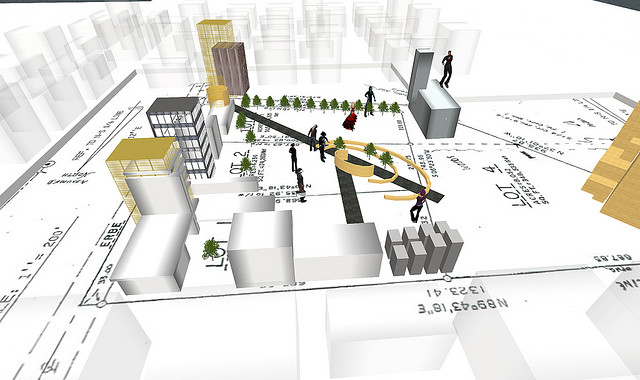
“Whilst the hype (and marketing interest) around virtualworlds has faded, the technology is increasingly being used in areas such as training & education,collaboration and data visualisation. This paper explores the on-going use, and future opportunity, of virtual worlds to help model the built environment, and as a result to use the virtual world to build a better physical world.”
There are a number of key differences here in comparison to more traditional Architecture, Engineering and Construction (AEC) visualisation tools.Principally that:
- The user is embodied in the world as an avatar, rather than having just a “camera” view
- The avatar/user can go where they like, and interact with the build
- The environment is multi-user, so users can interact with other users
- The environment is rendered in real-time, so although visual quality may not be as high, the environment can be far more dynamic and flexible, and renders instantly rather than needing an over-night render-farm.
I also appreciate their list of advantages of using virtual worlds in AEC fields:
The advantages of virtual worlds such as Second Life include:
• The ability to make changes instantly, in-world
• The ability to support multiple users in the same space – typically 50-100 (but of course you can always clone spaces)
• The ability to make things interactive – even linking computers to real computer applications, and signs to real signage systems
• The ability to not only integrate building environmental and performance data, but also to visualise it in new and effective ways
• The ability for users to peel-back layers of a building to see structural and service components
• The ability for users to annotate the space, feeding back comments which can be automatically collated
• The ability to track users through the building, and their interactions with its systems
• The ability to let users choose between configurations and vote on them
• The ability to support “live use” of the building, eg for entertainment or training
• The ability to clone the building to create multiple copies to explore what-ifs
• The ability to use the same platform to support virtual meetings, conferences, training, collaboration etc
• Dynamic rendering which enables the instant changes and multi-user deployment
Extranet Evolution has a great write-up (link) about this paper as well. Consequently, Paul Wilkinson’s twitter feed is also a must-follow resource for anyone interested in construction collaboration technologies (and more!) – follow him @EEPaul

